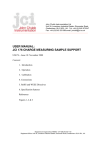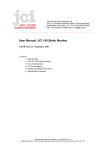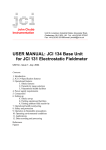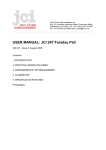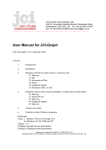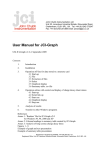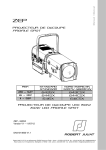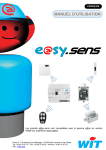Download USER MANUAL: JCI 147 Faraday Pail
Transcript
John Chubb Instrumentation Ltd Unit 30, Lansdown Industrial Estate, Gloucester Road, Cheltenham, GL51 8PL, UK. Tel: +44 (0)1242 573347 Fax: +44 (0)1242 251388 email: [email protected] ______________________________________________________________________________________________ USER MANUAL: JCI 147 Faraday Pail UM 147 - Issue 4: September 2007 Contents: 1. INTRODUCTION 2. PRACTICAL DESIGN FEATURES 3. ARRANGEMENTS FOR MEASUREMENT 3.1 JCI 140 mounting 3.2 Connections 3.3 Zeroing 3.4 Operational use 4. INSTRUMENT CHECKING AND CLEANING 5. CALIBRATION 6. SPECIFICATION FEATURES Figures Registered in England No 5798844. VAT GB 392 007 172 Registered Office: Unit 30, Lansdown Industrial Estate, Gloucester Road, Cheltenham, GL51 8PL, UK USER MANUAL: JCI 147 Faraday Pail For sensitive measurement of electrostatic charge on components and small quantities of materials 1. INTRODUCTION The JCI 147 Faraday Pail is a sensitive instrument for precise and reliable measurement of electrostatic charge. The sensitivity allows charges to be measured with a resolution down to 1pC. 2. PRACTICAL DESIGN FEATURES The unit comprises a Faraday Pail mounted on high quality insulation in a well defined mechanical arrangement relative to the sensing aperture of a JCI 140 Static Monitor. Charge placed in the pail raises the voltage of the pail a little, in relation to the capacitance of the pail, and the increase in voltage is measured by the JCI 140. The pail is relatively deep (a height to diameter ratio of 1.5) so all charge introduced into the pail couples to the pail and none to the surrounding shield - so long as the pail is not filled too much, not above about 40%. The charge appearing on the outside of the pail is equal to the nett quantity of charge placed into the pail. It is not necessary that the charge introduced conducts to the pail. The method of measurement is thus equally applicable to insulating and conducting components and materials placed in the pail. The shielding around the pail ensures that measurements are no affected by nearby static charges on people or surfaces. The attraction of a Faraday Pail based on the use of a 'field mill' type fieldmeter is the near zero charge leakage (limited only by insulation leakage, 1014 ohms or more) and the high sensitivity. If there is any doubt about the quality of the electrical insulation this may easily be tested by first temporarily earthing the pail and then observing on the JCI 140 the stability of the zero charge reading and then placing some charge in the pail and observing how slowly this leaks away. The JCI 140 Static Monitor is easily removable from the mechanical arrangement and can be used in its own right for other measurement purposes. All the normal features of the JCI 140 are available for use in the unit and versions of the JCI 140 can be used with any of the options available - for example the fast response version JCI 140F (3ms). JCI 140 instruments can be operated from an external mains power supply unit, JCI 142, via the 2.1mm d.c. power connector in the back plate and the analogue output can be linked to signal recording equipment . 3. ARRANGEMENTS FOR MEASUREMENT 3.1 JCI 140 mounting: The JCI 140 instrument is mounted into the JCI 147 unit by holding it between the fingers, on either side, and placing it with its sensing aperture end uppermost, obliquely into the channel between the two side plates so its top plate rests against the inside back surface. The JCI 140 is lifted up into position by two spring loaded fingers which may be pressed down either by a finger at the front or by lifting the lever at the back against the upper fixed stop. The bottom of the JCI 140 must be latched over the spring fingers and the lever gently released. Check that the sensing aperture of the JCI 140 is properly engaged into the hole in the baseplate of the Faraday Pail unit and that this sits fully up into the mounting hole. The JCI 140 may be easily removed from the unit by depressing the spring supporting fingers either at the front or by the lever extension at the back. 3.2 Connections: It is important that the unit is bonded to a reliable earth during use. The earth bonding point on the instrument is the green terminal towards the base of the right hand side support. The JCI 140 may be linked to analogue signal recording equipment for example a paper chart recorder or a digital storage oscilloscope (such as a Picoscope – www.picotech.com) via the 8w mini DIN socket in the back plate. It will probably be most convenient to insert the 8 pin miniature DIN plug into the JCI 140 before mounting into the JCI 147 unit. Details of connections are in the JCI 140 User Manual. 3.3 Zeroing Charge initially on the pail or left on the pail from previous observations is removed by pressing up the earthing button on the underside of the baseplate, towards the back. The operation can be seen when the outer case of the instrument is lifted off. 3.4 Operational Use The JCI 147 Faraday Pail unit may be used for measuring net electrostatic charge on any item or quantity of material which can be conveniently placed into the Pail. The quantity and polarity of the charge is indicated directly on the liquid crystal display of the JCI 140 as nanocoulombs. The sensitivity and stability of the measurement system is such that measurements can be made with a resolution of 1pC. Details of operational and performance features of JCI 140 instruments will be found in the instrument User Manual. Points to note about making measurements: a) It is advisable that the operator wears an over-garment which is ‘static dissipative’ and the garment and operator are bonded to earth. (Note that a ‘static dissipative’ surface is not necessarily one with a low ‘resistivity’ but one that does not retain any significant static charge or surface voltage after rubbing). It is also necessary to minimise any induction charging effects from charges on surfaces in the vicinity of the tests. The JCI 140 may be used to check the test environment and identify which items should be removed or shielded for example with earthed aluminium kitchen foil. b) Remove charge from the pail by pressing the earthing button. Check the 'zero' reading before making each measurement and note the value - this is particularly important when measuring small quantities of charge. c) Introduce charge into the pail and note the change in reading of the JCI 140. Take care to ensure that the introduced material or item enters the pail directly and does not touch any other surface before entering the pail. If the charge to be measured is on items slid down a surface (e.g. semiconductor devices slid down a shipping tube) it is important to connect the sliding surface to earth and make the measurements shielded from any local charges and electric fields. If it is necessary to use tweezers to introduce the item into the pail it is necessary to consider how to minimise charge generation at contact and any relative movement between the tweezers and the item and how to minimise any charge dissipation from the item away to earth through the tweezers. 1 d) So long as the item or material introduced does not fill the pail to a height more than about 40% it is not necessary to empty the pail each time - just to zero the reading before the next measurement. If the article or material introduced into the Faraday Pail unit fills the depth of the Pail by more than about 40% then charge at the top of the article may start to couple to nearby surfaces outside the pail and the total quantity of charge introduced may be underestimated. For such situations a deeper or larger Faraday Pail is needed. The cover of the Faraday Pail unit may easily be lifted off to access the pail and the pail removed for emptying and/or cleaning. 4. INSTRUMENT CHECKING AND CLEANING PTFE is used as the insulation mounting the pail support to provide good quality mechanical and electrical characteristics. If there is any doubt about the quality of the electrical insulation (for example if there may have been exposure to dust and dirt) or of possible influence of charge trapped on this insulation then this may be tested as follows: a) Zero drift: with the Faraday Pail system fully assembled press the earthing button, note the zero reading and then note whether this reading drifts with time. b) Charge leakage: Place some charge into the pail and observe on the JCI 140 how quickly this leaks away. From the capacitance of the pail (about 13pF) and the rate of decay of reading an effective leakage resistance can be calculated. The time for say 1% charge leakage should be long compared to the likely time for measurements to be made. Any loose dust, liquid or material which is spilt on to the inner surface of the baseplate should be removed. The three vent holes in the baseplate are provide to help this clearance. The pail and pail support are easily lifted clear and removed for cleaning. If any adjustment of sensitivity is needed this can be achieved by careful screw adjustment of the threaded adaptor on the underside of the pail support. Adjustment should only be made if appropriate instrumentation is available for reliable measurement of performance. 5. CALIBRATION Formal calibration is carried out to procedures described in BS 7506: Part 2: 1996 Annex. It is considered that calibration is best based upon measurement of the voltage sensitivity and the capacitance of the pail [1]. (Calibration based on inducing a charge on a sphere by raising it to a defined voltage are not considered as reliable). Formal calibration of a JCI 147 Faraday Pail needs to be made in conjunction with a particular JCI 140 instrument. The sensitivity may vary a little if used with other instruments because of small geometric differences around the sensing regions of individual JCI 140 instruments which may affect close proximity sensitivity. If the sensitivity needs to be modified it is necessary to change the position of the ‘adjuster’ surface that provides the coupling of the pail and its support to the sensing aperture of the JCI 140. To do this take off the outer shield and the pail and remove the 3 screws holding the pail support disc. Then lift off this disc and undo the M3 grub screw clamping the positin of the adjuster on the thread under the support disc. Unscrewing this adjuster will increase the sensitivity of the fieldmeter and also increase the capacitance of the pail. Measurement of the capacitance of the pail system needs to be made with the pail support disc in position, the pail sitting into this disc and the outer shield in place. The capacitance is usually around 13pF. The sensitivity of the JCI 140 may be checked by applying say 100V to the pail. The position of 2 the adjuster is changed until the value of the capacitance (pF) matches the JCI 140 reading equivalent to application of 1V to the pail – so for 13pF the target reading of the JCI 140 on the 2kV range with 100V on the pail will be 1.300. The grub screw should then be retightened, the pail support disc mounted back in position and the screws replaced and the calibration rechecked. [1] “Methods for the calibration of electrostatic measuring instruments” www.jci.co.uk/Calibration/Calibration.pdf 6. SPECIFICATION FEATURES Sensitivity ranges: 2,000 and 20,000pC FSD 1pC resolution Accuracy and linearity: +5% of range FSD on display and on analogue buffered output signal. - zero offset within +10 pC Controls: - manual earthing button for Faraday Pail - 3 position slide switch on JCI 140 for power on and sensitivity range selection JCI 140 Display: - nett charge into Faraday Pail in nC with display of polarity and LO BATT JCI 140 signal outputs: - LCD reading and sensitivity range signals via 8 way miniature DIN connector JCI 140 operation: - PP3 battery for JCI 140 and JCI 140F - mains power supply operation using JCI 142 via 2.1mm d.c connector Calibration: - the sensitivities of JCI 140 Static Monitor and JCI 147 Faraday Pail instruments are set up in manufacture using measurements whose accuracy is traceable to National Standards. Calibration to BS 7506: Part 2: 1996 available as extra. Dimensions: - 180x180mm baseplate, 335mm high - total weight about 3 kg 3 Figure 1: JCI 147 Faraday Pail unit Figure 2: JCI 147 with shield and pail separated 4






